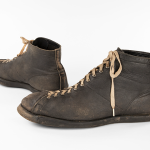Take a peek into our 14,000+ collection with our new blog series, From the Vault! Every other week, we’re sharing interesting stories about one of our artefacts.
What is the provenance of this pair? When did they enter the BSM collection?
These 19th century Ottoman bathhouse clogs called nalin were donated to the museum by Sonja Bata in 1985.
>
Are there any features that distinguish this pair from other footwear from the same period and geographical location?
Nalin from Turkey tend to be lower in height than other Ottoman examples such as those from Syria which can research heights of 26 cm. Turkish nalin are also more frequently decorated with elaborate silver inlay. This pair has exceptionally fine inlay and may have been made for use by a bride.



